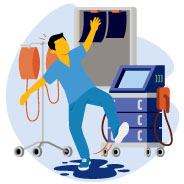Minimising the risk of common occupational injuries ?
One of the challenges when getting workplaces to enforce health and safety practices is getting them to put systems in place to manage some of the less obvious, but very common, occupational injuries that have an impact on the musculoskeletal system.

These injuries cause many people to be unfit for work, and for display screen equipment (DSE) workers, can have a big impact on their productivity when they are in the office.
Common occupational injuries
Carpal Tunnel Syndrome (CTS)
This is a common issue that affects the carpal tunnel running from the bottom of the wrist to the lower palm. Symptoms can include numbness, pain and a burning sensation. Common causes include excessive keyboard typing and work that involves excessive manual labour.
Hand Arm Vibration Syndrome (HAVS)
Some of the symptoms of this include a loss of feeling in the fingers and a numbness/tingling sensation. HAVS is particularly common in the construction industry where workers frequently use power tools and other heavy equipment.
Repetitive Strain Injury (RSI)
This is a fairly well-known issue that affects those working at desktops and other computers. It can develop when the same movement/task is performed over and over again. Whilst this is usually a mild issue it can be more dangerous if a heavier load is involved.
Whilst this list is not exhaustive of all musculoskeletal injuries and disorders, these are the most common that are seen within workplaces.
Steps to minimize the risk of occupational injuries to employees As well as encouraging staff to see a doctor for advice on occupation injuries, there are some things that can be done during work to reduce the risk of such injuries.
Encourage desk/work breaks
Just as having screen breaks helps with some eye-related issues in DSE workers, taking short breaks throughout the workday can help minimise the chance of illnesses like RSI occurring. It is also better for productivity in the long run.
Encourage your employees to adopt a good ergonomic posture
Many office workers and employees in other workplaces fail to adopt the correct posture when working. Finding ergonomic, chairs, keyboards, and other well-designed office equipment will help keep your workforce healthy and pain free.
Help foster open communication within the workplace
Another way you can help deal workplace-related illnesses is to foster an environment where employees feel comfortable raising any issues. This will help you work out how to alienate any issues in the future and improve the transparency of the health and safety practices in your office.
Taking the necessary action to reduce the threat of these health issues is essential if you are to keep a happy and productive workplace. As an employer, you should be making every effort to ensure your staff have the tools and equipment needed to do their job safely and effectively.



